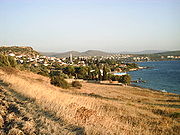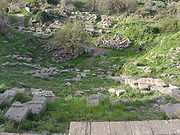
Erythrae
Encyclopedia


Ionian League
The Ionian League , also called the Panionic League, was a confederation formed at the end of the Meliac War in the mid-7th century BC comprising twelve Ionian cities .These were listed by Herodotus as*Miletus, Myus, and...
Ionia
Ionia
Ionia is an ancient region of central coastal Anatolia in present-day Turkey, the region nearest İzmir, which was historically Smyrna. It consisted of the northernmost territories of the Ionian League of Greek settlements...
n cities of Asia Minor
Asia Minor
Asia Minor is a geographical location at the westernmost protrusion of Asia, also called Anatolia, and corresponds to the western two thirds of the Asian part of Turkey...
, situated 22 km north-east of the port of Cyssus (modern name: Çeşme
Çesme
Çeşme is a coastal town and the center-town of the district of the same name in Turkey's western-most end, on a promontory on the tip of the peninsula which also carries the same name and which extends inland to form a whole with the wider Karaburun Peninsula...
), on a small peninsula stretching into the Bay of Erythrae, at an equal distance from the mountains Mimas and Corycus, and directly opposite the island of Chios
Chios
Chios is the fifth largest of the Greek islands, situated in the Aegean Sea, seven kilometres off the Asia Minor coast. The island is separated from Turkey by the Chios Strait. The island is noted for its strong merchant shipping community, its unique mastic gum and its medieval villages...
. It is recorded that excellent wine was produced in the peninsula.
History
According to Pausanias (Paus. 7.3.7), Erythrae was founded by Cretan settlers under the leadership of Erythrus the Red, son of Rhadamanthus, and at the same time inhabited by Lycians, Carians, and Pamphylians. At a later period came Knopos (Strab. 14.633), son of CodrusCodrus
Codrus was the last of the semi-mythical Kings of Athens . He was an ancient exemplar of patriotism and self-sacrifice. He was succeeded by his son Medon, who ruled not as king but as the first Archon of Athens....
, with an Ionian colony, whence the city is sometimes called Cnopopolis. The city did not lie exactly on the coast, but some little distance inland, and had a harbor on the coast named Cissus (Livy, 36.43).
In the 7th century BC as an Ionian city of Asia Minor, Erythrae was a member of the Pan-Ionian League. Sometime during the 7th century Erythrae fought a war against the neighbouring island of Chios. (Herodotus 1.18). The city gained fame as a producer of millstone
Millstone
Millstones or mill stones are used in windmills and watermills, including tide mills, for grinding wheat or other grains.The type of stone most suitable for making millstones is a siliceous rock called burrstone , an open-textured, porous but tough, fine-grained sandstone, or a silicified,...
during the period of tyrannical rule.
Erythrae was never a large city, it sent only eight ships to the Battle of Lade
Battle of Lade
The Battle of Lade was a naval battle which occurred during the Ionian Revolt, in 494 BC. It was fought between an alliance of the Ionian cities and the Persian Empire of Darius the Great, and resulted in a decisive victory for the Persians which all but ended the revolt.The Ionian Revolt was...
. The Erythraeans were for a considerable time subject to the supremacy of Athens
Athens
Athens , is the capital and largest city of Greece. Athens dominates the Attica region and is one of the world's oldest cities, as its recorded history spans around 3,400 years. Classical Athens was a powerful city-state...
, but towards the close of the Peloponnesian War
Peloponnesian War
The Peloponnesian War, 431 to 404 BC, was an ancient Greek war fought by Athens and its empire against the Peloponnesian League led by Sparta. Historians have traditionally divided the war into three phases...
they threw off their allegiance to that city. After the battle of Cnidus, however, they received Conon
Conon
Conon was an Athenian general at the end of the Peloponnesian War, who presided over the crucial Athenian naval defeat at Battle of Aegospotami; later he contributed significantly to the restoration of the political and military power.-Defeat at Aegospotami:Conon had been sent out following the...
, and paid him honours in an inscription, still extant.
Erythrae was the birthplace of two prophetesses (sibyl
Sibyl
The word Sibyl comes from the Greek word σίβυλλα sibylla, meaning prophetess. The earliest oracular seeresses known as the sibyls of antiquity, "who admittedly are known only through legend" prophesied at certain holy sites, under the divine influence of a deity, originally— at Delphi and...
s) --one of whom, Sibylla, is mentioned by Strabo
Strabo
Strabo, also written Strabon was a Greek historian, geographer and philosopher.-Life:Strabo was born to an affluent family from Amaseia in Pontus , a city which he said was situated the approximate equivalent of 75 km from the Black Sea...
as living in the early period of the city; the other, Athenais, lived in the time of Alexander the Great. The Erythraean Sibyl
Erythraean Sibyl
The Erythraean Sibyl was the prophetess of classical antiquity presiding over the Apollonian oracle at Erythrae, a town in Ionia opposite Chios, which was built by Neleus, the son of Codrus....
presided over the Apollo
Apollo
Apollo is one of the most important and complex of the Olympian deities in Greek and Roman mythology...
nian oracle
Oracle
In Classical Antiquity, an oracle was a person or agency considered to be a source of wise counsel or prophetic predictions or precognition of the future, inspired by the gods. As such it is a form of divination....
.
About 453 BC Erythrae, refusing to pay tribute, seceded from the Delian League. A garrison and a new government restored the union, but late in the Peloponnesian War (412 BC) it revolted again with Chios
Chios
Chios is the fifth largest of the Greek islands, situated in the Aegean Sea, seven kilometres off the Asia Minor coast. The island is separated from Turkey by the Chios Strait. The island is noted for its strong merchant shipping community, its unique mastic gum and its medieval villages...
and Clazomenae
Clazomenae
Klazomenai was an ancient Greek city of Ionia and a member of the Ionian Dodecapolis , it was one of the first cities to issue silver coinage.-Location:Klazomenai is located in modern Urla on the western coast of...
.
Later it was allied alternately with Athens and Persia. About the middle of the 4th c. BC the city became friendly with Mausolus: in an inscription found on the site he is called a benefactor of Erythrae. About the same time the city signed a treaty with Hermias, Tyrant of Assus and Atarneus, based on reciprocal aid in the event of war.
In 334 BC the city regained its freedom through Alexander the Great who, according to Pliny (HN 5.116) and Pausanias (2.1.5), planned to cut a canal through the peninsula of Erythrae to connect Teos bay with the gulf of Smyrna.
When Alexander returned to Memphis in April 331 BC, envoys from Greece were waiting for him, saying that the oracles at Didyma and Erythrae, which had been silent for a long time, had suddenly spoken and confirmed that Alexander was the son of Zeus. The timing proves that Alexander was already thinking that he was of a more than human nature when he entered Greece: after all, the people of Didyma and Erythrae can never have known that Alexander was recognized as the son of Ra and wanted to be called 'son of Zeus'.
Erythrae was later associated with Pergamum and with Rome, and after the death of Attalos III in 133 BC, when the Pergamene kingdom was bequeathed to the Romans, it flourished as a free city attached to the Roman province of Asia.
At this time, Erythrae was renowned for its wine, goats, timber, and millstones, as well as its prophetic sibyls, Herophile and Athenais.
In the Roman period the city was plundered and its importance faded after the earthquakes of that region in the 1st c. AD.
Recent times
By the mid. 18th century and up to early 20th century, Litri was a considerable place and port, extending from the ancient harbour to the acropolis. The smaller coasting steamersSteamboat
A steamboat or steamship, sometimes called a steamer, is a ship in which the primary method of propulsion is steam power, typically driving propellers or paddlewheels...
call, and there was an active trade with Chios (Sakiz in Turkish) and Smyrna
Smyrna
Smyrna was an ancient city located at a central and strategic point on the Aegean coast of Anatolia. Thanks to its advantageous port conditions, its ease of defence and its good inland connections, Smyrna rose to prominence. The ancient city is located at two sites within modern İzmir, Turkey...
which is called Izmir
Izmir
Izmir is a large metropolis in the western extremity of Anatolia. The metropolitan area in the entire Izmir Province had a population of 3.35 million as of 2010, making the city third most populous in Turkey...
in modern Turkey. Erythrae is called Ildir or Ildiri in Turkish and not to be confused with the hotel in the village called Erythrae.
Remains
The archaeological site is situated within the settlement zone of the present-day Turkish village of IldırıIldiri
Ildırı formerly known as Lytri is a picturesque sea-side village belonging to the administrative district of Çeşme in Turkey's İzmir Province and located about twenty-five kilometers north of Çeşme town, facing Chios....
. The site was explored in depth in the 1960s by Professor Ekrem Akurgal
Ekrem Akurgal
Ekrem Akurgal was a Turkish archaeologist. During a career that spanned more than fifty years, he conducted definitive research in several sites along the western coast of Anatolia such as Phokaia , Pitane , Erythrai and old Smyrna Ekrem Akurgal (March 30, 1911 – November 1, 2002) was a ...
, leading to precious discoveries, but has been left somewhat unattended since. The ruins include well-preserved Hellenistic walls with towers, of which five are still visible. The acropolis (280 ft) has an amphitheatre
Amphitheatre
An amphitheatre is an open-air venue used for entertainment and performances.There are two similar, but distinct, types of structure for which the word "amphitheatre" is used: Ancient Roman amphitheatres were large central performance spaces surrounded by ascending seating, and were commonly used...
on its northern slope, and eastwards lie many remains of Byzantine
Byzantine
Byzantine usually refers to the Roman Empire during the Middle Ages.Byzantine may also refer to:* A citizen of the Byzantine Empire, or native Greek during the Middle Ages...
buildings.
External links
- History of Erythrae Created by Dale E. Landon, Professor Emeritus of History, Indiana University of Pennsylvania
- The Princeton Encyclopedia of Classical Sites
- Encyclopaedia Britannica Concise
- View Erythrai in Google Earth
- The Temple of Athena Polias at Erythrae

